High Frequency and High-speed printed circuit boards
Transfer large quantities of data wirelessly
The interconnected nature of everyday life requires the transmission of large amounts of data – just think of streaming a video or using an app. Mobile networks and other wireless data transmission infrastructure require high-frequency signals to do this. However, this entails a number of problems. The higher the frequency, the higher the losses during transmission, which in turn leads to higher energy consumption. So electronic systems that process high-frequency signals need the shortest possible conducting paths to function efficiently.
High-frequency & high-speed printed circuit boards from AT&S meet these requirements perfectly, thus opening the way for ultra-fast communication networks.
Product benefits at a glance
- Allows antennae and signal processing to be integrated in a complete package.
- The compact design ensures shorter signal pathways.
- Low losses during signal transmission and processing.
Faster networks
The trend towards higher frequencies is set to continue over the coming years. The 5G mobile networks currently under construction use very high-frequency signals in the millimetre wave spectrum. To process these signals efficiently, the base stations of mobile phone networks will have to adopt completely new antenna technology in the future. The circuits used to process the antenna signals must be packed as densely as possible, so they are designed as high-frequency printed circuit boards.

Dynamic duos
Connection technology from AT&S makes the whole greater than the sum of its parts
High-frequency & high-speed printed circuit boards from AT&S feature short signal pathways that are reliable, unrivalled in speed and consume less power. An alternative is to use a simpler analogue circuit for the antenna and install this on a separate, less expensive printed circuit board. Both options meet the specific circuit requirements perfectly for the antenna and signal processing.
The two circuit boards for the antenna and the signal processing are assembled into a single unit at the end of production and delivered as a finished component. This type of connection has no need for plugs or wires that would otherwise lead to losses.
Radar, laser and satellites
Besides 5G and (in future) 6G mobile networks, other application areas rely on processing high-frequency signals effectively. High-resolution radar, laser sensors and satellite communication can be implemented with maximum efficiency using high-frequency printed circuit boards from AT&S.


Technical data
| Product Characteristics | Specifications |
|---|---|
| Z-Interconnect Paste | Electrical resistance: 35 μΩ*cm |
| Materials for low-loss signal transmission | Dielectric materials (Low Dk / low Df materials) and copper foils
|
| Nickel-free surface finish for components integration |
|
You may also be interested in these topics
New technologies developed by AT&S will soon allow network operators to utilize smaller base stations that can provide faster data transmission and lower latency while using less power. These breakthroughs will enable the upcoming 6th generation of mobile networks, finally fulfilling the promise of mobile broadband internet even in very crowded places.
What comes after 5G? The Austrian technology company makes an important contribution to the development of tomorrow’s mobile communication and radar technologies and is already working on 6G.
For vehicles to operate as autonomously as possible in the future they must meet completely new requirements in data processing and sensor technology. Cutting edge technology by AT&S enables high-resolution scanning of the surroundings as well as processing and transferring the data volume incurred.




